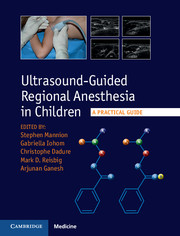Book contents
- Frontmatter
- Contents
- List of contributors
- 1 Introduction
- Section 1 Principles and practice
- 2 Performance of regional anesthesia in children
- 3 Pharmacology of local anesthetics in children
- 4 Management of complications of regional anesthesia
- 5 Basics of ultrasonography for regional anesthesia in children
- 6 Anatomy of the neuraxis, thoracic and abdominal walls, upper and lower limbs
- Section 2 Upper limb
- Section 3 Lower limb
- Section 4 Truncal blocks
- Section 5 Neuraxial blocks
- Section 6 Facial blocks
- Appendix: Muscle innervation, origin, insertion, and action
- Index
- References
5 - Basics of ultrasonography for regional anesthesia in children
from Section 1 - Principles and practice
Published online by Cambridge University Press: 05 September 2015
- Frontmatter
- Contents
- List of contributors
- 1 Introduction
- Section 1 Principles and practice
- 2 Performance of regional anesthesia in children
- 3 Pharmacology of local anesthetics in children
- 4 Management of complications of regional anesthesia
- 5 Basics of ultrasonography for regional anesthesia in children
- 6 Anatomy of the neuraxis, thoracic and abdominal walls, upper and lower limbs
- Section 2 Upper limb
- Section 3 Lower limb
- Section 4 Truncal blocks
- Section 5 Neuraxial blocks
- Section 6 Facial blocks
- Appendix: Muscle innervation, origin, insertion, and action
- Index
- References
Summary
Introduction
The use of regional anesthesia in pediatric surgery has been increasing over the last 30 years. Successful neural blockade is essential for good-quality analgesia. Ensuring this can be difficult in pediatric practice, as these techniques can be difficult in younger children due to the close anatomic relationship between nerve and adjacent structures. The use of ultrasound guidance has grown exponentially in recent years in both adults and children. Some blocks that had fallen out of favor, such as the paravertebral and supraclavicular blocks, are increasing as a result of the use of ultrasound. New techniques based on ultrasonography have also appeared. Ultrasound guidance allows visualization of anatomic structures and the accuracy of the local anesthetic (LA) injection. This chapter provides an overview of basic ultrasound technology and equipment use. It will also describe how to identify different structures and some advantages of ultrasound in pediatric regional anesthesia. Ultrasound for specific blocks will be discussed in the relevant block chapters.
Basic principles of ultrasonography
The ultrasound or sonographic image is based on mechanical oscillations of a quartz crystal excited by electrical pulses (piezoelectric effect). Ultrasound probes contain multiple piezoelectric crystals, which are interconnected electronically and vibrate in response to an applied electric current. An ultrasound beam is a continuous or intermittent train of waves emitted by a transducer or probe. These vibrating mechanical sound waves create alternating areas of compression and refraction when propagating through body tissues. Ultrasound waves are characterized by their frequency (measured in cycles per second or hertz), their wavelength (measured in meters), and their velocity (speed of wave through a medium) (Marhofer, 2011).
The wavelength and frequency of ultrasound are inversely related, i.e. ultrasound of high frequency has a short wavelength and vice versa. Ultrasound frequencies are always higher than 20 000 Hz, which is the upper limit for audible human hearing. Medical ultrasound devices use sound waves in the range of 1–20 MHz. Proper selection of transducer frequency is an important concept for providing optimal image resolution in diagnostic and procedural ultrasound.
As ultrasound waves travel through tissues, they are partly transmitted to deeper structures, partially reflected back as echoes by the different anatomic structures to the transducer, partially scattered, and partially transformed to heat. For imaging purposes, we are mostly interested in the echoes reflected back to the transducer.
- Type
- Chapter
- Information
- Ultrasound-Guided Regional Anesthesia in ChildrenA Practical Guide, pp. 30 - 39Publisher: Cambridge University PressPrint publication year: 2015



